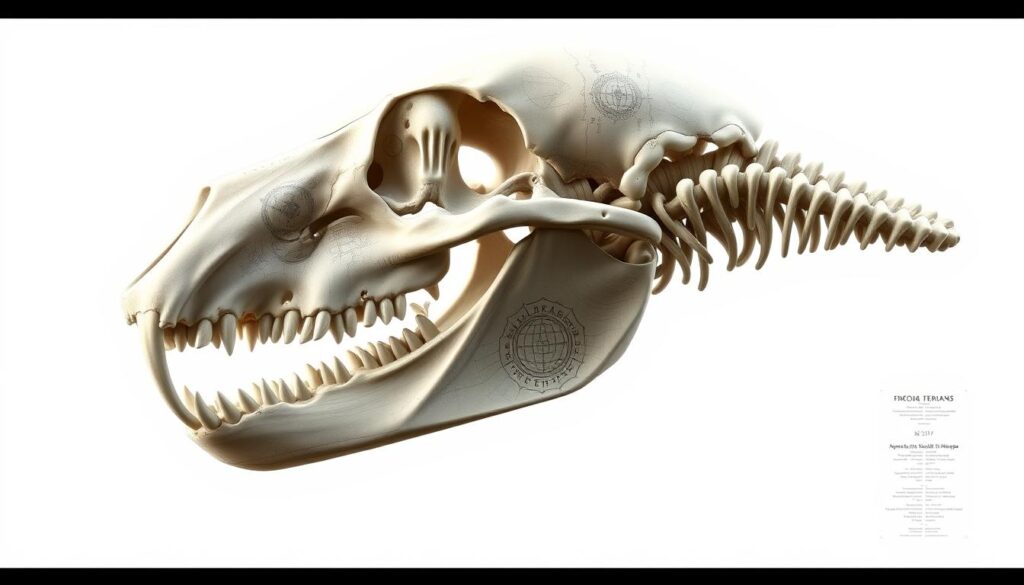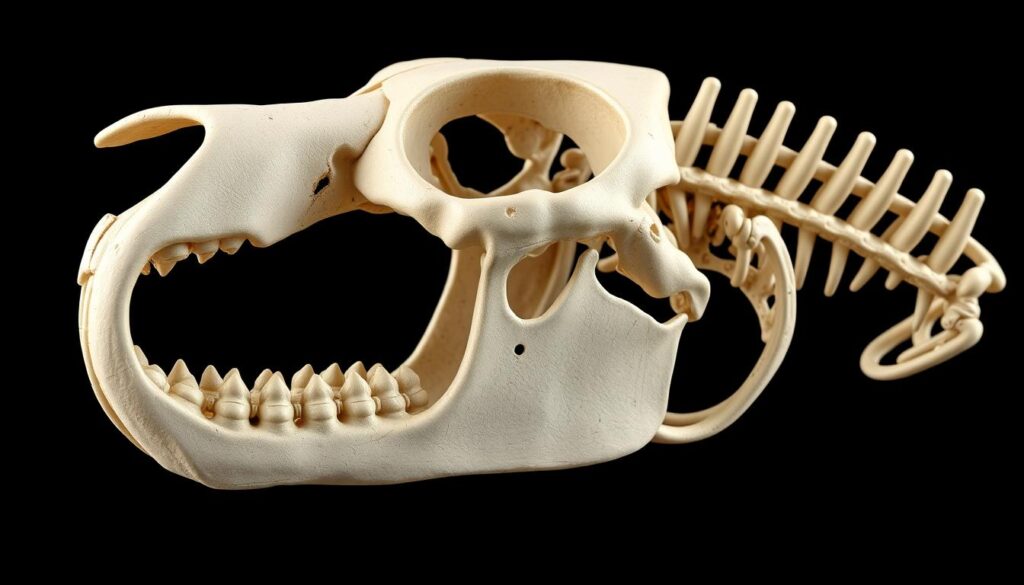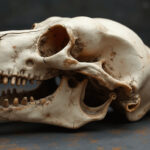Exploring canine anatomy reveals the dog skull’s fascinating world. It comes in many shapes and sizes, depending on the breed. The dog skull is more than just bones; it supports the brain, senses, and overall health of your dog.

Learning about the dog skull helps you understand your dog better. It shows the amazing diversity of dog breeds. From the tiny Chihuahua to the massive Great Dane, each has a unique skull shape and size. These reflect their evolutionary history and how they adapt to their environment.
Introduction to Canine Cranial Structure
As you dive deeper into the dog skull, you’ll see how its parts work together. This includes bones, muscles, and sensory organs. The dog skull is key to your dog’s anatomy. Knowing about it can make you appreciate your dog’s biology and behavior more.
Key Takeaways
- The dog skull is a complex bony structure that supports the brain, senses, and overall physiology of your dog.
- The canine skull comes in a variety of shapes and sizes across different breeds, reflecting their evolutionary history and functional adaptations.
- Understanding the dog skull can provide insights into the unique characteristics of your canine companion.
- The canine skull is part of the broader category of animal skulls, offering a glimpse into the remarkable diversity of dog breeds.
- Exploring the dog skull can deepen your appreciation for the biology and behavior of your furry friend.
- The dog skull plays a crucial role in understanding dog evolution and biology.
Understanding the Basic Anatomy of a Dog Skull
Exploring dog anatomy means learning about the dog skull’s basic structure. The skull is made of bones and cartilages that form the cranium. This complex system protects the brain and sensory organs.
Dog skulls vary in shape and size, depending on the breed. The skull’s anatomy is shaped by breed, age, and genetics. For example, some breeds have longer skulls, while others have shorter, broader ones.
Major Bones and Structures
The dog skull has several key bones like the frontal, parietal, and occipital bones. These bones form the cranium, which safeguards the brain and sensory organs. The skull’s design balances protection with flexibility and movement.
Skull Shapes Across Breeds
Each breed has its own skull shape, shaped by genetics and breeding history. For instance, Greyhounds have long, narrow skulls, while Bulldogs have shorter, broader ones. Knowing these differences helps us appreciate each breed’s unique features.

Growth and Development
The dog skull changes a lot as a puppy grows into an adult. The skull evolves to fit the growing brain and sensory organs. Exploring dog anatomy reveals the fascinating and complex structure of the dog skull.
| Breed | Skull Shape | Unique Characteristics |
|---|---|---|
| Greyhound | Long, narrow | Designed for speed and agility |
| Bulldog | Short, broad | Distinctive wrinkles and facial structure |
The Evolutionary Journey of the Canine Cranium
Exploring dog skulls reveals a deep history. The canine cranium’s evolution spans millions of years. It has changed a lot, influenced by environment, diet, and genetics.
Some key milestones in canine evolution include:
- The emergence of the first canine-like species, such as Hesperocyon and Mesocyon, during the Paleocene epoch.
- The development of more advanced species, such as Canis lepophagus, during the Miocene epoch.
- The diversification of modern dog breeds, which has resulted in a wide range of animal skull shapes and sizes.

Studying the canine cranium’s evolution helps us understand dogs and their environment. It also highlights the value of preserving natural history specimen for future generations.
| Epoch | Event | Result |
|---|---|---|
| Paleocene | Emergence of first canine-like species | Development of early canine characteristics |
| Miocene | Development of more advanced species | Diversification of modern dog breeds |
Unique Features of Dog Skull Anatomy
Looking at a dog skull, you’ll see many special features. It’s made of different bones and spaces. These help with breathing, eating, and feeling the world around them. Even a replica of a dog skull can teach us a lot about our furry friends.
The nasal cavity is really interesting in dog skulls. The shape and size of the nasal cavity change a lot between breeds. This affects how well they can smell. For example, some dogs can smell better because of their longer, narrower nasal cavities.
Nasal Cavity Structure
The jaw and teeth of a dog skull are also unique. The jaw is strong for biting and chewing. The teeth are shaped for eating meat. They have incisors, canines, and molars to help break down food.
Jaw Mechanics
Knowing about dog skull anatomy is helpful in many ways. Veterinarians use this knowledge to care for dogs’ teeth. It helps keep dogs healthy and happy. Whether you’re a vet, dog owner, or just love dogs, learning about dog skull anatomy is fun and educational.
Comparing Dog Skulls Across Different Breeds
Exploring dog anatomy shows big differences in pet skeletons across breeds. These differences come from selective breeding. For example, a dog’s skull size and shape can change its jaw shape and dental structure. This reflects the breed’s history and purpose.
Breed standards are key in shaping dog anatomy. Veterinary studies have found important differences in skeletal structures. These include skull shape and size, jaw alignment, and dental arrangement.
- Skull shape and size
- Jaw alignment and dental arrangement
- Nasal cavity structure
These differences come from breed-specific traits. Traits like hunting ability, athletic performance, or companionship traits.
Looking at dog anatomy and pet skeletons of different breeds helps us understand their history. It also shows how their development was influenced. Whether you’re a dog owner, breeder, or just a fan, learning about dog skulls is fascinating. It gives us insights into their biology and behavior.
| Breed | Skull Shape | Jaw Alignment |
|---|---|---|
| Greyhound | Narrow and elongated | Scissor-like |
| Bulldog | Brachycephalic (short and broad) | Underbite |
| German Shepherd | Mesaticephalic (medium-sized) | Scissor-like |
The Role of Dog Skull Structure in Sensory Functions
The dog skull is key to a dog’s senses. It helps dogs smell, hear, and see well. These senses are important for how dogs behave and interact with their world.
The dog skull’s design is fascinating. It shows how animals evolved to sense their surroundings better. Dogs can smell things we can’t because of their skull’s special features. This helps them track prey.
Dogs also hear better than many animals. Their skull’s shape lets them pick up sounds we can’t. This is crucial for dogs to communicate and move around.
Looking at the dog skull, we see it’s made for sensing. Its size and shape help dogs think and see well. This lets them notice changes in their environment.
| Sensory Function | Dog Skull Structure |
|---|---|
| Olfactory Capabilities | Highly developed nasal cavity and large olfactory bulb |
| Hearing Mechanisms | Shape and size of auditory canal and eardrum |
| Visual Processing | Large brain-to-body mass ratio and optimized skull shape |
In summary, the dog skull is vital for their senses. By studying it, we learn more about dogs’ anatomy, senses, and behavior.
Common Conditions Affecting the Dog Skull
As a dog owner, knowing about common health issues in your pet’s skull is key. The dog’s bone structure is vital for their health. Conditions like cranial fractures, dental problems, and congenital defects can affect the skull.
These issues can stem from genetics, trauma, or infection. For example, cranial fractures might happen from accidents or falls. Dental problems can arise from bad oral care or a misaligned bite. Congenital defects are present at birth and might need surgery.
Common symptoms include:
- Pain or swelling in the skull area
- Difficulty eating or swallowing
- Changes in behavior or personality
- Visible deformities or abnormalities in the skull
A vet can do a physical check, X-rays, and more. They’ll give a diagnosis and treatment plan. Knowing about dog anatomy helps you see why quick vet care is important.
Regular vet visits can catch problems early. Keeping your dog healthy includes good food, exercise, and a safe home. This helps keep them well overall.
Preservation and Cleaning Methods for Dog Skulls
Preserving a dog skull is key to keeping it in great shape for years. Whether you’re buying a dog skull for sale or already have one, cleaning and preserving it right is crucial. A well-kept skull replica adds value to any natural history specimen collection.
First, understand the need for proper cleaning and preservation. You can use gentle soap and water or get help from a professional. Techniques used in taxidermy and museum conservation can also help preserve a dog skull.
Here are some important tips for keeping a dog skull clean and preserved:
- Handle the skull with care to avoid damaging it
- Use gentle cleaning products to avoid discoloration
- Store the skull in a cool, dry place to prevent deterioration
By following these steps, you can keep your dog skull in top shape for a long time. Whether you’re an experienced collector or just starting, proper care is key to maintaining your natural history specimen collection.
Remember, a well-preserved dog skull is a valuable addition to any collection. With the right care, it will remain a cherished skull replica for years. If you’re looking to buy a dog skull for sale, make sure it’s been well-preserved and cleaned.
| Preservation Method | Description |
|---|---|
| Natural Cleaning | Using gentle soap and water to clean the skull |
| Professional Preservation | Seeking the help of a professional preservation service |
| Storage Requirements | Storing the skull in a cool, dry place to prevent deterioration |
Scientific Applications of Dog Skull Studies
Studying the dog skull offers many scientific benefits. It helps us understand dog evolution, health, and behavior. By looking at the dog skull, scientists learn more about canine biology and its importance to humans.
The study of dog skulls is crucial for veterinary medicine. It helps vets diagnose and treat skull injuries and diseases better. It also guides the creation of new treatments for dogs.
Veterinary Medicine
- Diagnosing skull-related injuries and diseases
- Developing new treatments and therapies for canine health issues
- Understanding the evolution of canine biology
Archaeological Significance
The dog skull is also key in archaeology. Ancient dog skulls tell us about human-canine history, like domestication and migration. By studying dog skull shapes, researchers can learn about our past and our bond with dogs.
In summary, studying dog skulls gives us a lot of information about dogs. It helps us improve veterinary care and archaeology. This knowledge enriches our understanding of the world and our role in it.
| Field of Study | Application of Dog Skull Studies |
|---|---|
| Veterinary Medicine | Diagnosing and treating skull-related injuries and diseases |
| Archaeology | Reconstructing the history of human-canine interactions |
How to Identify and Authenticate a Dog Skull
Understanding dog anatomy is key when identifying a dog skull. Look for the skull’s shape and size, the nasal cavity’s structure, and the teeth’s arrangement. A pet skeleton, like a dog skull, can tell a lot about the animal’s health and growth.
To check if a dog skull is real, examine its dog bone structure against known examples. Look at the skull’s cranium shape, muzzle length, and orbit shape. These details help figure out if it’s a dog and what breed it might be.
- The shape and size of the skull
- The structure of the nasal cavity
- The arrangement of the teeth
- The overall dog bone structure
By studying these features and the dog anatomy closely, you can decide if the skull is genuine. This is important for collectors, researchers, or anyone interested in pet skeleton anatomy.
Ethical Considerations in Dog Skull Collection
Collecting dog skulls raises important ethical questions. As a collector, you must act with respect and follow the law. A dog skull offers insights into dog biology and behavior.
Before you get a dog skull, learn the legal rules. In the U.S., laws control animal remains collection. Knowing these laws helps avoid trouble. Ethical sourcing is key for a valuable collection.
Legal Requirements
Some key considerations include:
- Obtaining necessary permits and licenses
- Ensuring that the specimen was obtained legally and humanely
- Complying with regulations regarding the collection and trade of animal remains
Sourcing Guidelines
To ensure your collection is ethical, follow these guidelines:
- Source specimens from reputable suppliers or institutions
- Support conservation efforts and sustainable practices
- Prioritize education and research over personal gain
By following these guidelines, you can create a responsible dog skull collection. It will help us understand these fascinating specimens better.
Educational Value of Dog Skull Specimens
Studying a dog skull is fascinating. It offers insights into canine anatomy and biology. You can learn about the skull’s structure and function, like the nasal cavity and jaw mechanics.
In schools, animal skull specimens, like dog skull replicas, are great for teaching. They help students understand the natural world. They spark curiosity and appreciation for learning.
Here are some ways skull replica specimens are used in education:
- Teaching anatomy and biology classes
- Creating interactive museum exhibits
- Developing educational programs for schools and universities
Using dog skull specimens in education makes learning fun and interactive. It inspires students to explore the natural world. Whether you’re a teacher, student, or just curious, a skull replica is a valuable tool for learning about anatomy and biology.
Conclusion: The Remarkable Nature of Canine Cranial Structure
The dog skull is truly amazing, showing us a lot about our canine friends’ evolution and adaptations. It comes in many shapes, depending on the breed. The nasal cavity, jaws, and teeth work together in a clever way.
By studying the dog skull, we learn about their incredible senses. They can smell things we can’t and see and hear clearly. This knowledge helps in vet care and archaeology, showing how important these studies are.
The dog skull is more than just a cool biological find. It lets us see into the fascinating world of dogs. By learning about the dog skull, we gain a deeper respect for these animals. So, keep exploring and marveling at the dog skull’s wonders.
FAQ
What are the major bones and structures that make up a dog skull?
A dog skull is made of several important bones. These include the cranium, mandible, maxilla, and facial bones. They protect the brain, support the jaw and teeth, and help with senses like smell, hearing, and vision.
How do dog skull shapes vary across different breeds?
Dog skull shapes differ a lot between breeds. This shows their unique histories and purposes. For example, pugs and bulldogs have short, flat skulls, while greyhounds have long, narrow ones.
What is the evolutionary journey of the canine cranium?
The canine cranium has a fascinating history. It goes back to the earliest dog ancestors. Fossil evidence shows how the skull changed over time, adapting to diet, habitat, and behavior changes.
What are some unique features of dog skull anatomy?
Dog skulls have special features. They have a big nasal cavity for smelling, strong jaws for eating, and teeth for a meat diet.
How do dog skull structures differ across breeds?
Different breeds have different skull structures. For instance, a Chihuahua’s skull is much smaller than a Great Dane’s. This shows their unique histories and uses.
How does the dog skull structure support sensory functions?
The dog skull supports their amazing senses. It has a big nasal cavity, ears, and eyes. These help dogs smell, hear, and see better than humans.
What are some common conditions that can affect the dog skull?
Dog skulls can face health issues like fractures, dental problems, and birth defects. Quick vet care is key to keeping dogs healthy.
How can I properly preserve and clean a dog skull?
Cleaning and preserving a dog skull needs care. Use natural methods, professional services, and right storage to keep it real and intact.
What are the scientific applications of studying dog skull structure?
Studying dog skulls helps in vet medicine and archaeology. It gives insights into dog health, behavior, and history with humans.
How can I identify and authenticate a dog skull?
To identify a dog skull, know its anatomy and how it differs from others. Use vet anatomy and forensic anthropology resources to ensure it’s legal and ethical.
What are the ethical considerations in collecting dog skulls?
Collecting dog skulls requires legal knowledge and ethics. Always respect animal welfare, follow laws, and get them from the right places.
How can dog skull specimens be used for educational purposes?
Dog skull specimens are great for learning. They teach anatomy, biology, and natural sciences. They also spark curiosity and appreciation for dog diversity.
